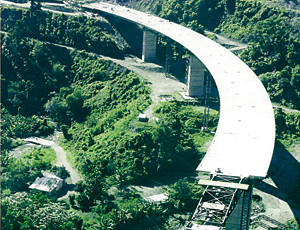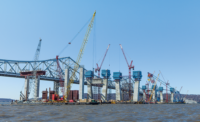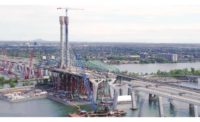Hillman joined Swiss post-tensioning firm VSL in 1990 to work on a 385-m-long incrementally launched bridge in Utuado, Puerto Rico. Six months later, the project manager left the job. Hillman, then age 27, found himself in charge of completing a type of structure built only once before in the Western Hemisphere. And it was slowly collapsing.

It was an incrementally launched bridge being pushed across the piers by 1,000-ton rams supported on the abutments, says Elvin Wright, then VSL project superintendent. But the project was behind schedule and in trouble. Wright credits Hillman with saving the day. “One day he just shows up on site,” he recalls. “He looks like he’s about 20 years old now. Just think how he looked then—like he was out of high school. But he turns out to be this crack engineer.”
The ducts for the longitudinal post-tensioning tendons were too close to the bottoms of the concrete boxes, says Hillman. “There was one span where, every time we launched the mid-span portion over the piers, the sliding pads would crush into the bottom of the segment,” he recalls. “At one location in particular, we ground out the box girder on the pier. Had we continued launching, the pier would have been pulled over, and the bridge would have collapsed.”
Under Hillman’s direction, crews jacked up the bridge at that pier location and repaired the superstructure. “I remember being on the scaffolding with my concrete foreman, injecting epoxy into the side of the girder on a Sunday night in pouring rain so we could continue launching on Monday,” he says.
Once launching resumed, the team had to monitor the displacement at the top of the pier. “If the pier went too far, it could have buckled,” says Hillman. The bridge was completed, but no plans existed on how to remove the temporary, intermediate steel towers required for launching. Some of the towers were as tall as 120 ft with two 20-ton concrete pier caps at the top for the launching surfaces.
Hillman devised a plan: Take the 12-ft-deep launching trusses that cantilever off the front end of the bridge and use them to create a lifting frame positioned transversely to the piers. Crews then took the two 1,000-ton rams and positioned them on top of the deck. They drilled holes through the completed bridge to run lifting strands down to the truss frame. The rams lifted the frame snug against the bottoms of the concrete pier caps. “We used the hydraulics to lift the top half of the tower,” says Hillman. “Once we slipped the bottom halves of the towers out from underneath, we were able to lower the top halves of the towers to the ground.”





Post a comment to this article
Report Abusive Comment